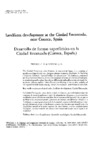Landform development at the Ciudad Encantada, near Cuenca, Spain

View/
Use this link to cite
http://hdl.handle.net/2183/6152Collections
Metadata
Show full item recordTitle
Landform development at the Ciudad Encantada, near Cuenca, SpainAlternative Title(s)
Desarrollo de formas superficiales en la Ciudad Encantada (Cuenca, España)Date
1993Citation
Cadernos do Laboratorio Xeolóxico de Laxe, 1993, 18: 257-269 ISSN: 0213-4497
Abstract
Resumen] La Ciudad Encantada, cerca de la ciudad de Cuenca, es morfológicamente un conjunto de rocas fungiformes, restos de platafórmas elongadas y arcos naturales
modelados sobre dolomitas cretácicas de estructura subhorizontal. Su origen se atribuye a factores estructurales, presencia de estratos con diferente resistencia a la erosión, y ataque generalizado de la humedad primero subedáficamente y luego subaéreamente al pie de las formas actuales. Los factores que contribuyen a la estabilidad actual en la parte superior de estas formas, son los recubrimientos biológicos, la concentración de calcita o las variaciones locales en el régimen de humedad. Abstract] The Ciudad Encantada, near Cuenca, in east-central Spain, is a complex of mushroom-shaped rocks and elongate plateau remnants developed in flat-lying Cretaceous dolomite. Natural bridges are also presento The forms are attributed partly to structural factors, namely the presence of strata of contrasted resistance to weathering and erosion, but also to differential subsurface moisture attack beneath the plateau surface. Other factors contributing to the relative stability of the caprock include biotic coating, calcite concentration, and dryness at site scale.
Keywords
Mushroom-shaped rocks
Landform development
Ciudad Encantada
Rocas fungiformes
Desarrollo morfológico
Landform development
Ciudad Encantada
Rocas fungiformes
Desarrollo morfológico
ISSN
0213-4497





